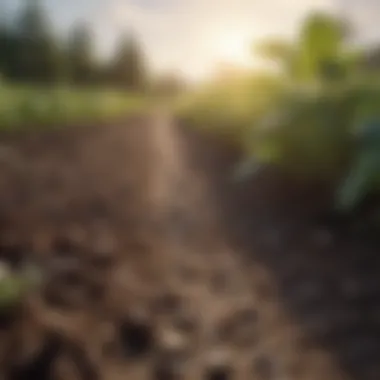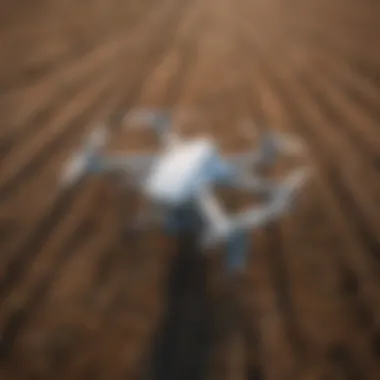Practical Applications of Precision Agriculture


Intro
With the agricultural landscape continuously evolving, precision agriculture stands out as a beacon of hope for modern farming. This approach combines technology and traditional methods into a finely-tuned system, enabling farmers to optimize their operations while minimizing resource waste. The significance of this transformation cannot be overstated; it is reshaping how food is produced and consumed globally. In this exploration, we will unpack various practical implementations of precision agriculture, aiming to highlight methodologies such as the use of sensors, drones, and data analytics that enhance efficiency and sustainability in agriculture.
Over the years, farming techniques have largely remained unchanged, often leading to inefficiencies and unsustainable practices. However, the advent of new technologies has ushered in a revolution, allowing agriculture to harness real-time data for better decision-making. For instance, the utilization of soil sensors can provide critical insights about moisture levels, nutrient content, and even pest activity in real time. Implementing this kind of technology allows farmers to tailor their inputs more precisely, ultimately leading to higher yields with less environmental impact.
Moreover, drones have become an integral part of this modern farming toolkit. These unmanned aerial vehicles can cover vast areas in a short period, capturing high-resolution images and collecting data crucial for monitoring crop health. Not only do these technologies assist in assessing the fields, but they also foster a more proactive approach to farming, enabling farmers to identify potential issues before they escalate.
In addition, data analytics plays a key role in synthesizing the information gathered from various sources, transforming raw data into actionable insights. By analyzing trends and patterns, farmers can make informed decisions that enhance productivity and sustainability. The combination of these advanced methodologies positions precision agriculture as a progressive force in the agricultural sector.
As we delve deeper into specific implementations and case studies, we will illustrate the potential of precision agriculture not just in improving crop yields but also in promoting environmental stewardship. The marriage of technology and agriculture is not merely an option—it’s a necessity for future sustainability. This narrative will not only explore these technologies and case studies but also provide a comprehensive understanding of their impacts on the agricultural landscape.
Preamble to Precision Agriculture
Precision agriculture is more than a trending buzzword in today’s farming landscape; it's a pivotal shift towards more diligent, sustainable, and efficient agricultural practices. The advent of this approach signifies how technology can be harnessed to optimize crop yields while minimizing resource waste. In an era where the world's population continues to burgeon, and the demands on agricultural outputs climb, understanding the principles of precision agriculture is crucial.
Definition and Overview
At its core, precision agriculture refers to the practice of utilizing technology and data analysis to monitor and manage field variability in crops. This encompasses a wide range of methodologies, from the adoption of advanced sensors to the application of geographic information systems (GIS). The driving idea behind precision agriculture is to treat the farm as a collection of segments rather than viewing it as a monolithic whole. This allows growers to apply resources more effectively, ensuring optimum growth conditions for each part of their land.
Some key components of precision agriculture include:
- Soil and crop sensors that provide real-time data on nutrient levels and soil moisture.
- Remote sensing technologies, such as drones and satellite imagery, that offer insights on plant health and growth patterns.
- Data analytics software that assists farmers in interpreting this complex data, thus facilitating informed decision-making.
This approach not only helps in increasing productivity but also plays a vital role in promoting sustainability. Farmers can decrease the use of fertilizers and pesticides, leading to less runoff and improved soil health.
History and Evolution
The history of precision agriculture is deeply intertwined with the advent of new technologies over the decades. The journey began in the 1980s when the agricultural sector started to explore the possibilities brought about by computer technology. Initially, this was purely at the level of record-keeping and diagnostic tools. The term 'precision agriculture' itself began to gain traction in the late 1990s, mainly coinciding with the development of global positioning systems (GPS).
With the introduction of GPS, farmers could accurately map their fields and monitor small shifts in yield and other critical factors such as soil composition. Over time, satellite imaging became more accessible, paving the way for the integration of remote sensing technologies. These advancements enabled farmers to identify issues earlier in their crop cycle, which is essential for effective intervention.
The 21st century has seen an explosion of intelligent devices, data analysis capabilities, and the Internet of Things, which are now integral elements of modern agriculture. As we move forward, it's clear that precision agriculture will continue to evolve, shaped by emerging technologies, ongoing challenges in food production, and the pressing need for ecological stewardship.
"Precision agriculture can greatly enhance productivity while also addressing critical sustainability concerns." - Agricultural Technology Expert
Technological Components of Precision Agriculture
Precision agriculture thrives in the synergy between traditional farming methods and cutting-edge technology. The core of this evolution lies within its technological components, which play a pivotal role in enhancing productivity, optimizing resources, and promoting sustainability.
Innovations like data collection tools, remote sensing technologies, drones, and Geographic Information Systems (GIS) have fundamentally altered how farmers approach cultivation and resource management. Each component serves distinct functions but collectively drives the agricultural sector toward a more efficient and eco-conscious direction.
Data Collection Tools
Data collection is the backbone of precision agriculture. It allows farmers to gather crucial information about their fields, leading to informed decisions that significantly impact productivity and sustainability. Among the various tools available, soil sensors, climate sensors, and moisture sensors stand out.
Soil Sensors
Soil sensors are instrumental in collecting real-time data regarding soil health. They measure parameters like pH levels, nutrient content, and moisture, proving essential for precision farming.
- Key Characteristic: Their ability to provide instant feedback on soil conditions allows farmers to respond promptly.
- Benefit: The timely information aids in making better decisions about fertilization and irrigation, directly correlating with improved yields.
- Unique Feature: Some advanced soil sensors even integrate with smartphone apps, making it easier for farmers to track their data on-the-go.
- Advantage: Immediate insights can prevent over-fertilization and irrigation, leading to cost savings.
- Disadvantage: Initial setup costs can be high, and farmers must ensure they are trained to interpret the data effectively.
Climate Sensors
Climate sensors, measuring environmental conditions like temperature and humidity, allow farmers to adapt their practices in response to changing atmospheric conditions.
- Key Characteristic: Consistent monitoring ensures that crops receive optimal conditions for growth.
- Benefit: This can minimize the risks associated with extreme weather events.
- Unique Feature: Many modern climate sensors can connect to the internet, providing updates and alerts anytime.
- Advantage: Reduces the likelihood of crop loss due to unforeseen climates.
- Disadvantage: A dependence on technology might lead to a sense of complacency, and unexpected sensor failures can lead to critical lapses in monitoring.
Moisture Sensors
Moisture sensors track water levels in the soil, ensuring that crops aren’t over or under-watered—crucial for maintaining healthy plant growth.
- Key Characteristic: These sensors can pinpoint areas of the field that require watering versus those that are already adequately hydrated.
- Benefit: Optimized irrigation fosters water conservation, a key component in sustainable farming.
- Unique Feature: Some models offer alerts when moisture drops below a critical level, prompting timely intervention.
- Advantage: Reduces water wastage and optimizes crop health through precise watering schedules.
- Disadvantage: Misinterpretation of readings without proper calibration can lead to irrigation failures.


Remote Sensing Technologies
Remote sensing technologies like satellite imaging, aerial imagery, and thermal imaging provide vital aerial views that traditional methods often miss. These technologies offer broader coverage, capturing insights into crop health and soil conditions that ground-level data collection might overlook.
Satellite Imaging
Satellite imaging allows for large scale monitoring of farmlands, far beyond what a drone can provide.
- Key Characteristic: Offers insights into extensive agricultural areas, capturing high-resolution imagery that highlights crop health discrepancies.
- Benefit: Gives farmers an overarching view, helping in identifying problems like pest infestations or disease outbreaks earlier.
- Unique Feature: Regular satellite passes mean that updates can be frequent, offering timely data for crop management.
- Advantage: Enables strategic planning for field management, ultimately driving better yield.
- Disadvantage: Costly subscriptions to satellite data services can be a barrier for smaller farms.
Aerial Imagery
Aerial imagery uses manned or unmanned aircraft to take detailed photographs of the fields.
- Key Characteristic: Provides closer views, enabling detailed assessments of crop conditions.
- Benefit: Farmers can visually identify specific areas that require attention, promoting targeted interventions.
- Unique Feature: Flexibility in flight times and target areas makes aerial imagery highly bespoke.
- Advantage: Can be conducted more frequently than satellite imaging, allowing for a more dynamic approach to field management.
- Disadvantage: Weather conditions can complicate planning flights, affecting the frequency of data collection.
Thermal Imaging
Thermal imaging maps temperature variances across fields, offering insights into crop stress—subtle changes that might indicate issues before they become severe.
- Key Characteristic: Measures heat emitted from plants, providing data that often correlates with water stress and other health issues.
- Benefit: Early detection can lead to interventions that save crops from more significant losses.
- Unique Feature: The ability to cover vast areas quickly allows farmers to get a comprehensive assessment in less time.
- Advantage: Facilitates timely watering and pest control responses, enhancing yield.
- Disadvantage: Analysis requires expertise; misinterpretation of thermal data can lead to poor decision-making.
Drones in Agriculture
Drones are increasingly becoming the Swiss Army knife of precision agriculture, equipped for an array of tasks ranging from crop monitoring to pest control. As these flying devices become more affordable and sophisticated, their role expands significantly in farming operations.
Crop Monitoring
Drones are deployed for real-time crop monitoring, capturing images that can reveal critical data about crop health.
- Key Characteristic: Quick aerial surveys save time compared to ground assessments.
- Benefit: Enabling a fast-response mechanism reduces delays in crop intervention measures.
- Unique Feature: Drones can fly at different altitudes and angles, offering a variety of perspectives on crop fields.
- Advantage: Provides detailed, immediate data that can be used to make swift decisions.
- Disadvantage: Requires training to operate drones effectively and analyze the data gathered.
Pest Control
Drones have advanced to the stage where they can not only assess but also treat pest problems.
- Key Characteristic: Capable of delivering pesticide and herbicides precisely where needed.
- Benefit: Focuses treatment only on affected areas, reducing waste and minimizing ecosystem impact.
- Unique Feature: Automated flights can carry out treatments on a predetermined schedule.
- Advantage: Saves both time and resources, improving efficiency.
- Disadvantage: Regulatory compliance and potential off-target pesticide drift issues can affect effectiveness.
Soil Analysis
Drones can aid in analyzing soil conditions across vast expanses quickly.
- Key Characteristic: Rapid assessments can spot problem areas needing immediate action before the problem worsens.
- Benefit: Faster responses lead to healthier crops and optimized yields.
- Unique Feature: Can combine multiple types of sensors for a comprehensive approach.
- Advantage: May reduce the overall cost of soil monitoring over time.
- Disadvantage: Dependence on technology necessitates competent personnel capable of technical operations.
Geographic Information Systems (GIS)
Geographic Information Systems serve as the analytical layer atop the data collected through various channels. These systems integrate information from sensors, satellites, drones, and even traditional data sources
- GIS helps in analyzing spatial data systematically.
- Key Characteristic: Visual representation makes it simpler to identify patterns and anomalies in field data.
- Benefit: With spatial analysis, farmers can devise strategies that hone in on specific yield issues, optimizing harvesting methods.
- Unique Feature: The ability to overlay various data sets such as pest sightings and crop health leads to informed decision-making.
- Advantage: Enhanced planning and resource allocation promote not only efficiency but financial savings.
- Disadvantage: Complexity in software can pose learning challenges for farmers new to technology.
In summary, the technological components of precision agriculture offer an expansive toolkit for modern farmers. From soil sensors to drones and GIS, these innovations facilitate a move toward more precise, sustainable farming practices.
Data Management and Analysis
Data management and analysis represent the backbone of precision agriculture. In today's agricultural landscape, keeping track of an ever-growing amount of data is vital for effectively managing resources, minimizing waste, and enhancing sustainability. With the right approaches, farmers can harness this data to inform their decisions, ultimately leading to improved crop yields and a healthier ecosystem.
The importance of data management cannot be overstated. Farmers are inundated with data from various sources—sensors measuring soil quality, drones providing aerial imagery, and weather forecasts. Without a coherent strategy for managing this information, it could quickly become overwhelming, creating confusion rather than clarity.
In addition, efficient data analysis is critical. It allows farmers to identify patterns, predict trends, and make data-driven decisions. For instance, they could analyze previous harvest data to determine optimal planting times or apply nutrient levels tailored to specific areas of their fields. Effective use of data can shed light on practices that elevate yield and make operations more efficient, rather than simply guessing or following outdated methods.
Precision Agriculture Software
Precision agriculture software plays a central role in data management. These platforms offer comprehensive tools that help in collecting, processing, and visualizing data conveniently. Farmers can access satellite imagery and other relevant analytics all in one place, simplifying their workflow.
Additionally, many leading software options allow for integration with existing farm equipment. It means farmers can pull data from their machinery directly into the software, streamlining their operations. Data such as GPS coordinates, yield variations, and past weather conditions can be analyzed simultaneously, enabling more informed decision-making. Popular software platforms such as Ag Leader Technology and Trimble offer robust features catered to both novice and experienced farmers.


Big Data in Agriculture
Big data has become a buzzword in many industries, and agriculture is no exception. The sheer volume of data collected in farming today opens doors to unprecedented opportunities. Farmers who embrace big data can analyze vast datasets, leading to insights that may have once gone unnoticed.
For example, big data can be utilized to understand market demand and supply trends. By correlating crop performance data with market prices, farmers can make purchasing and selling decisions based on solid insights rather than assumptions. This connectivity brings a competitive edge in the market.
However, it is imperative to recognize the challenges related to managing big data. Data privacy, security issues, and ensuring the compatibility of data systems can create roadblocks. As farmers navigate this terrain, they must consider the potential risks while harnessing the benefits of big data for agricultural advancement.
Machine Learning and AI Applications
The role of machine learning and AI in precision agriculture is becoming increasingly pronounced. These technologies can analyze data at scales and speeds impossible for humans, uncovering insights that can help farmers make smarter choices.
For instance, machine learning models can predict pest outbreaks by analyzing historical weather patterns alongside recent field data. Likewise, AI can optimize irrigation schedules based on real-time moisture levels, ensuring crops receive exactly what they need without wasting water.
Moreover, machine learning algorithms can assist in classifying soil types within a field. When farmers understand the variability in their fields, they can tailor their management practices accordingly, maximizing efficiency and sustainability.
"Data is a crucial asset in precision agriculture, but it’s how we manage and analyze that data that shapes the future of farming."
Case Studies in Precision Agriculture
Case studies in precision agriculture play a pivotal role in illustrating how theoretical concepts translate into real-world applications. They provide practical insights and highlight the transformative potential of adopting precision farming methods. This section examines notable implementations within the sector, presenting a nuanced understanding of both successful strategies and the challenges farmers face in integrating new technologies.
Successful Implementations
Case Study of Vineyard Management
Vineyards stand as a prime example of successful precision agriculture. Many vineyard managers are adopting technologies, like soil moisture sensors and satellite imagery, to enhance grape quality and yield while reducing waste. A significant aspect of vineyard management is the careful monitoring of microclimates within the vineyard. Each section of a vineyard may have different light exposure and soil types, demanding tailored care.
One key characteristic of this case study is the implementation of variable rate irrigation systems, which allow growers to apply water only where it’s needed. This targeted approach conserves water and optimizes water-use efficiency, which is crucial given the increasing instances of drought conditions in many wine-growing regions.
"Using precision agriculture data, vineyard managers can make informed decisions on irrigation practices. It’s not just about watering plants; it’s about watering them when they need it most."
A unique feature of vineyard management is the integration of drone technology. Drones equipped with thermal cameras can assess vine health, allowing for early detection of potential disease outbreaks. While the initial investment in drone technology may seem steep, the long-term benefits—better crop quality and higher yields—often justify the costs. However, there's a learning curve with technology, and some vineyard owners might feel daunted by this transition.
Row Crop Management
Row crop management presents another compelling case study. This method involves growing crops in rows, allowing for easier access to fields and facilitating the use of equipment. A major contribution of row crop management comes from precision planting tools that optimize seed placement and spacing. It ensures that each seed gets the right amount of nutrients and water, maximizing yield potential.
A notable characteristic of row crop management is the adoption of yield monitoring systems. These systems track yield data in real time, enabling farmers to analyze performance across different zones of the field. By utilizing this information, farmers can adjust their practices accordingly, enhancing productivity.
A unique aspect of row crop management is the integration of cover crops into the rotation. They play a role in improving soil health and reducing erosion. While they add complexity to the farming operation, the benefits—such as enhanced soil structure and nutrient retention—often outweigh the disadvantages. Farmers need to weigh the costs and the potential for increased efforts in managing multiple crop cycles.
Challenges Faced
Despite the success stories, challenges abound in the realm of precision agriculture. One of the primary hurdles is the high number of data sources and the need for cohesive data management. Farms today generate an overwhelming amount of information—from soil health to yield data—making it challenging to draw actionable insights without appropriate analytics tools.
Another notable challenge involves the initial investment and technology adoption speed. Some farmers may find it hard to embrace the changes due to financial constraints or lack of knowledge about new technologies. Navigating the complexities of integrating various systems also presents obstacles, as many producers are accustomed to traditional farming techniques.
As precision agriculture continues to evolve, farmers will need to stay informed about best practices and emerging technologies. In doing so, they can not only improve their operations but also contribute to more sustainable farming practices.
Impact of Precision Agriculture on Sustainability
The significance of precision agriculture in promoting sustainability cannot be understated. It provides a framework through which farmers can optimize their resource use, making agricultural practices more efficient while reducing their environmental footprint. In today’s world, with climate change creeping ominously on us, addressing sustainability isn't just an option; it's a necessity. Precision agriculture employs different technologies and methodologies that ensure the balance between productivity and ecological health is maintained.
Resource Efficiency
Water Conservation
Water is one of the most precious resources in farming. The implementation of precision agriculture significantly enhances water conservation. Techniques such as the use of soil moisture sensors, which gauge the moisture content in real-time, play a colossal role here. This means that irrigation can be applied just when it's needed, thus eliminating the excess used by traditional methods.
The key characteristic here is responsiveness; farmers get to make decisions based on current conditions rather than preset schedules. This not only conserves water but also nourishes crops effectively when they require it the most, promoting healthier yields. One unique aspect of this practice is the potential to integrate weather forecast data with soil metrics. When these insights are coupled, it creates a robust system minimizing waste. However, implementing these systems can be costly and require technical know-how, which may be a barrier for some farmers.
Nutrient Management
Nutrient management is another area where precision agriculture excels, facilitating greater sustainability in farming. By employing techniques such as variable rate technology (VRT), farmers can optimize fertilizer applications based on specific field conditions and crop needs. This avoids blanket applications, which can lead to soil degradation and unnecessary chemical runoff into waterways.


The significant advantage of nutrient management through precision agriculture is its dual benefit: improving soil health and enhancing crop yields. This tailored application allows for a focus on what the soil needs, which not only fosters a healthier ecosystem but also maximizes profitability. However, just like water conservation, the precise knowledge of soil nutrient status requires frequent monitoring and analysis, which can be resource-intensive, and some farmers might shy away from these practices.
Biodiversity and Ecosystem Health
Precision agriculture encourages practices that promote biodiversity and support ecosystem health. By using technologies that facilitate selective harvesting and targeted interventions, farmers can protect non-target species and maintain the ecological balance of their land. Interventions can be designed not only around crop types but also around the various plants and animals present. This makes farming more of a symbiotic relationship rather than a traditional exploitation of resources. When farmers focus on biodiversity, they create resilient ecosystems that are less prone to pests and diseases and can better withstand climate fluctuations.
Carbon Footprint Reduction
Lastly, precision agriculture has a tangible impact on reducing the carbon footprint of farming operations. Techniques that enhance efficiency lead to lower fuel consumption, decreasing overall greenhouse gas emissions. For instance, precision tillage methods minimize soil disturbance, which not only helps to retain soil carbon but also reduces the energy required for tilling. When operations scale up these methods, the cumulative effect on carbon emissions can be significant.
The integration of renewable energy sources within precision agriculture practices also contributes to reducing the overall carbon footprint. Farmers looking to transition towards solar-powered equipment or wind energy not only enable cleaner operations but also promote long-term sustainability. Such steps further emphasize that not just reactive measures can be employed; proactive approaches are crucial as well.
"The path to sustainable agriculture runs through precision farming, where every drop of water and pinch of nutrient counts towards a healthier planet."
Future Trends in Precision Agriculture
As the agricultural landscape continues to evolve, the topic of Future Trends in Precision Agriculture holds significant relevance in understanding how technologies are reshaping the way we farm. This section explores the groundbreaking innovations on the horizon, emphasizing both the promise they carry for productivity and the considerations that come along with these advancements. With challenges like climate change and food security looming large, the adoption of new technologies presents not just opportunities, but a compelling need for adaptation and evolution in farming practices.
Emerging Technologies
Blockchain in Agriculture
Blockchain in Agriculture emanates as a robust concept facilitating transparency and supply chain efficiencies. One key characteristic of this technology is its ability to create immutable records of data transactions. This fosters trust among stakeholders by ensuring that data regarding crop origins, treatment, and handling is secure and easily traceable. Such features make blockchain not only beneficial but also a popular choice in modern agriculture.
Its unique feature lies in the decentralized nature of its structure, which reduces risks of tampering or fraud.
The advantages include enhanced traceability of food, which is crucial for regulatory compliance and consumer confidence, particularly in an age where consumers demand to know where their food comes from. However, there are disadvantages too. The initial implementation costs and the need for broader internet access in rural areas could pose significant barriers.
In short, integrating blockchain technology into agriculture could revolutionize not just how we document but also how we perceive the safety and quality of our food.
IoT in Farming
The IoT in Farming captures attention with its potential to connect devices and gather actionable data in real-time. This technology allows farmers to monitor crop conditions remotely, leading to well-informed decision-making that boosts efficiency. The key characteristic of IoT in agriculture is its capability to facilitate communication via interconnected devices which can send alerts for anomalies like pest infestation or moisture levels.
One unique feature of IoT is the use of smart sensors, which can gather diverse data points such as soil temperature, humidity, and crop growth status. These sensors provide continuous insights that make farming both precise and timely.
Among the advantages, IoT helps optimize water usage and reduce inputs of fertilizers and pesticides, enhancing sustainability. Yet, the disadvantages include dependency on technology that may not be accessible to all farmers, particularly in developing regions, potentially widening the gap in agricultural productivity.
Global Perspectives
When we consider Global Perspectives on precision agriculture, it's vital to recognize the varied implementation of these technologies. Regions around the world face different climatic challenges and economic pressures that influence how precision farming is adopted. Countries like the United States and Canada have advanced infrastructures, allowing for widespread adoption of technologies such as drones and data analytics. In contrast, developing nations often rely on traditional methods, with access to modern tech being limited.
In addition, cultural factors play a role in embracing change. Farmers in some regions may be hesitant to adopt new methods due to traditional practices or lack of knowledge, highlighting the importance of education and training.
Moreover, international partnerships can facilitate knowledge transfer and resource sharing, aiding in the global dissemination of effective practices. Overall, understanding these perspectives not only paints a complete picture of precision agriculture's future but also helps identify the gaps that need addressing for comprehensive global progress.
Epilogue and Implications
Precision agriculture offers a landscape rich with possibilities, transforming how we view farming. It is not merely a trend; it is a crucial shift towards sustainable practices that can enhance productivity while respecting environmental limits. The implications of this movement reach far beyond the confines of the fields. They touch on economic viability, resource management, and food security.
Farmers who embrace precision agriculture practices can optimize the use of water and fertilizers, reducing waste and cutting costs. Emerging technologies such as sensors, drones, and AI facilitate a more informed approach to farming. These innovations allow growers to monitor their crops’ health, analyze soil conditions, and make rapid adjustments based on real-time data.
In addition to increased efficiency, there are significant benefits to the ecosystem. By using precision techniques, farmers can reduce runoff into nearby waterways, thus enhancing water quality. Moreover, the capability to accurately apply inputs minimizes excess, which can lead to better soil health and biodiversity.
"Sustainable farming is not only about caring for our planet—it’s about ensuring future generations inherit a viable world of agricultural opportunities."
The importance of this evolving approach cannot be overstated. As the global population continues to rise, the methods we use to produce food will determine our ability to sustain our societies. Precision agriculture’s focus on data-driven solutions ensures that we are not just farming harder, but smarter.
This article establishes that the pathways forward in agriculture are intertwined with technology. As farmers, researchers, and policymakers work together, the solutions derived from precision practices will become more widely applicable and are required for broadscale adoption in the farming community.
Summary of Key Findings
- Enhanced Efficiency: The integration of technology such as sensors and data analytics leads to more efficient use of resources, ultimately reducing costs for growers.
- Environmental Preservation: Precision agriculture minimizes environmental impact, promoting better water quality and soil health through targeted application of inputs.
- Increased Yields: Data-informed decisions help in maximizing crop yields by providing the right conditions in real time.
- Economic Viability: Farmers adopting these methods can experience reduced financial risks through better resource management.
Call for Further Research
The ongoing evolution of precision agriculture necessitates continued research into its applications. Several areas stand out for future inquiry:
- Integration of Emerging Technologies: What can newer technologies, such as blockchain and IoT, offer in supporting precision agriculture practices?
- Socio-Economic Impacts: How can precision agriculture positively transform rural economies while addressing farmers' concerns about technology adoption?
- Long-Term Sustainability: Further studies are needed to understand the long-term environmental impacts of precision farming on ecosystems.
Encouraging the academic and research communities to delve deeper into these issues can shed light on how precision agriculture will shape the future of farming. As we continue to refine these practices, the insights gained could lead to innovations that not only benefit farmers but also the communities that depend on their produce.







